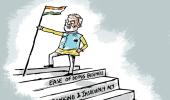NITI Aayog has not said what the reasons were for having achieved or not having achieved what was sought to be achieved, or what lessons can be learned for the future, points out Aakar Patel.

Since we have entered the phase of Kartavyakal, it may be instructive to see what happened in Amritkal.
In 2017, NITI Aayog began putting together a five year plan based on a call given by the prime minister.
In August that year, Narendra D Modi had pledged and asked others to pledge to creating a 'new India' by 2022.
NITI Aayog consulted with the ministries and the states and a host of other individuals and institutions before coming up with a 200 page document of what would be achieved.
A total of 1400 'stakeholders' was consulted and the strategy was signed off by Modi, who wrote that 'let us combine our energies to achieve the targets outlined in the Strategy, thereby fulfilling the aspirations of our citizens.'
The targets on the side of the economy were in the main: Take GDP growth to 8%; raise investment rates to 36%; raise tax-to-GDP to 22%; take female labour participation rates to 30%; improve data collection on employment; double the rate of growth of the manufacturing sector through Make in India; double farmers' income.
What has happened on these fronts is now known and has been reported and commented on the pages of this organ several times over but it is necessary to summarise.
The rate of GDP growth began to soften and fell in almost sequential fashion quarterly beginning in January 2018.
For 13 quarters before the pandemic it plummeted before arriving at 3.1% in the last quarter of 2019-2020.
Some sleight of hand was suggested here and the former chief economic advisor said that the numbers were inflated by 2% or so.
After that the pandemic arrived and economic activity was hit. If we grow at 8% this year we will have lost two years of growth.
The investment rate remains where it was, under 30%. The tax-to-GDP ratio fell from 11% in 2019 to about 10% in 2020 and has gone back to about 11%, though taxes on fuel have increased significantly.
It is unclear how NITI Aayog assumed that 22% was possible, especially after the cut in the rate of direct taxes given to India's corporate sector in 2019.
The story of labour force participation has been documented at length by the Centre for Monitoring the Indian Economy.
The Economic Survey's figures are similar and India is at a labour force participation rate of 40%, the lowest in South Asia and about half that of China and Vietnam, both of which are over 70%.
The government's own data also suggests the same, and the worrying thing is that the rate has seen a long term and secular decline (explained by Santosh Mehrotra and others) which this government has not acknowledged and therefore not sought to correct.
Of course, one part of the problem is the very poor rate of female participation, but even the male participation is anaemic because the jobs are not there.
On data collection, again this paper has recorded the issues with the Consumer Expenditure Survey, which was not released despite a plea from the previous chief economic advisor.
Specifically on unemployment data, the NITI Aayog itself discredited a National Sample Survey report showing that unemployment had hit a record 6%.
Released after the election results were out, the data were validated and unemployment has remained over 6%.
On December 29, 2019, PTI reported that 'the statistics ministry has constituted a 28 member Standing Committee on Statistics (SCES) chaired by former Chief Statistician Pronab Sen to improve quality of data amid criticism of the government over political interference' and quoted Sen saying that 'the first meeting of the SCES is scheduled on January 6, 2020. The agenda would be very broad based. We will come to know about that only in the first meeting next month.'
No further news or mention is to be found of this committee.
Manufacturing did not grow and instead manufacturing's share of GDP actually fell from 16% before Make in India to about 13% today.
Jobs in manufacturing have also fallen.
The automobile sector, which is half of all manufacturing, has been flat for a decade.
India produced (for domestic and export markets combined) a total of 3.4 million passenger vehicles in 2014-2015 and 3.4 million in 2019-2020, before the pandemic.
The average of the last three years, discounting the supply chain problems and catching up of demand lag, produces similar numbers.
The Society of Indian Automobile Manufacturers sent out an SOS in 2021 after assessing its growth rates for three years till March 2020 (before the pandemic).
It concluded that 'there is a slowdown in the Indian automobile industry that is long term, structural and deep" and that 'more research needs to be done on this slowdown.'
But research is only done on those problems that we acknowledge the existence of, and there is no slowdown in India, according to the government.
The income of farmers did not double, of course. The Reserve Bank of India's Consumer Confidence Survey tracking current perceptions compared to a year ago on the economic situation, employment and inflation has been trending negative for seven straight years (except for March-April 2019).
Even exports, seen as a success story last year, climbed after being negative for most part since 2014.
India had topped $300 billion in merchandise exports in 2014.
A 23% boom in global trade after Covid lifted all boats in 2021-22.
That boom is over and merchandise exports are again registering negative growth.
This then is the record of New India@75. Halfway into 2023, there is no further reference to this five year plan.
NITI Aayog has not said what the reasons were for having achieved or not having achieved what was sought to be achieved, or what lessons can be learned for the future.
Instead, the prime minister has now renamed our time. Amritkal, the eternal era, was apparently not eternal and the era of duty is now upon us.
Aakar Patel is a columnist and writer and you can read Aakar's earlier columns here.
Feature Presentation: Aslam Hunani/Rediff.com










